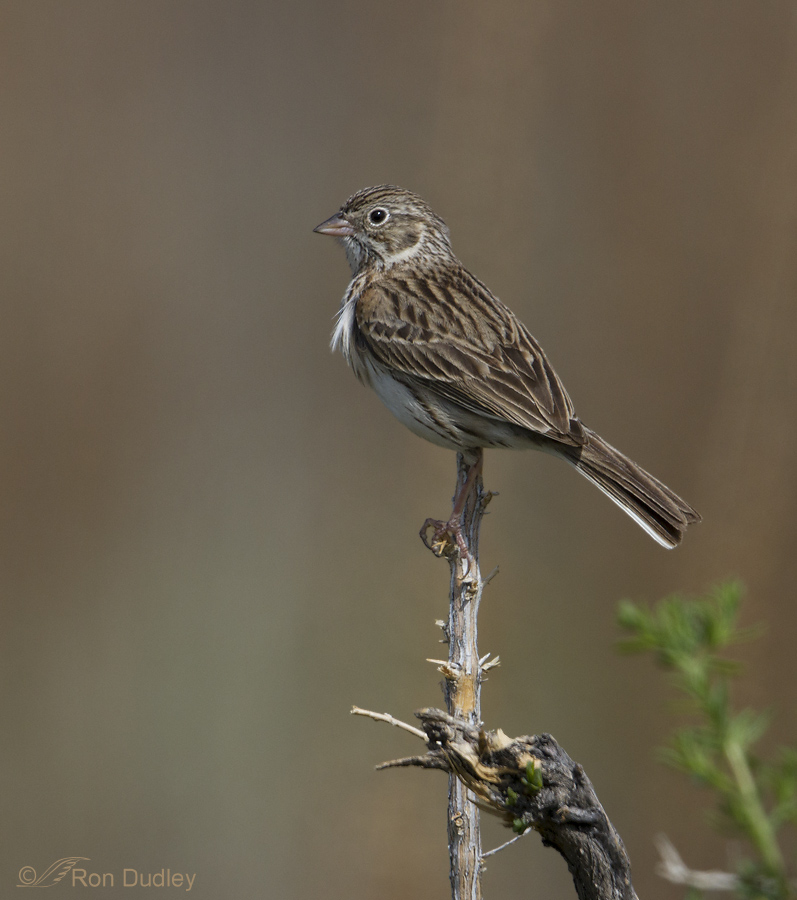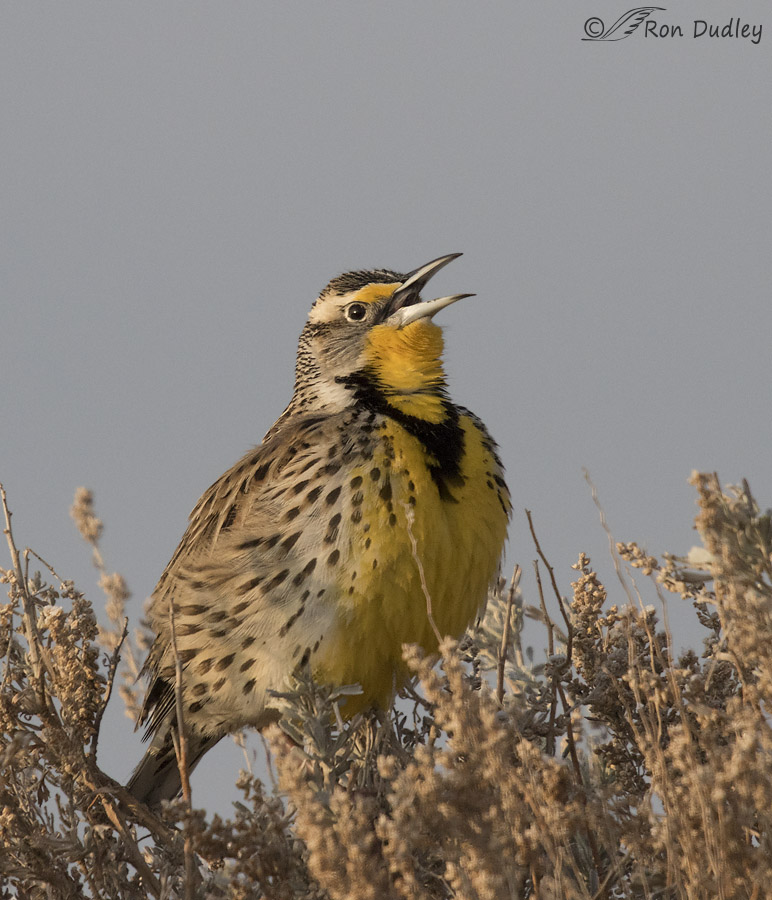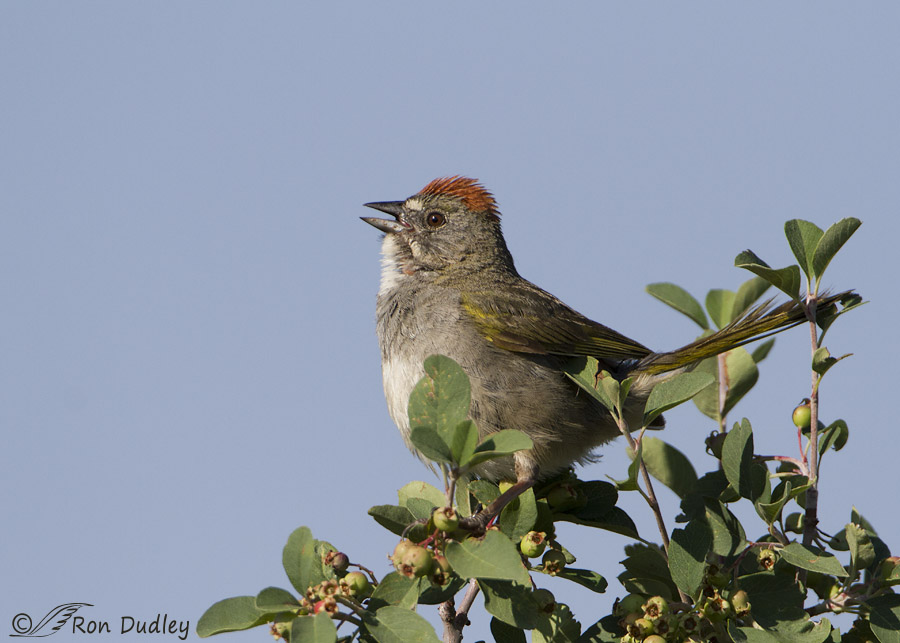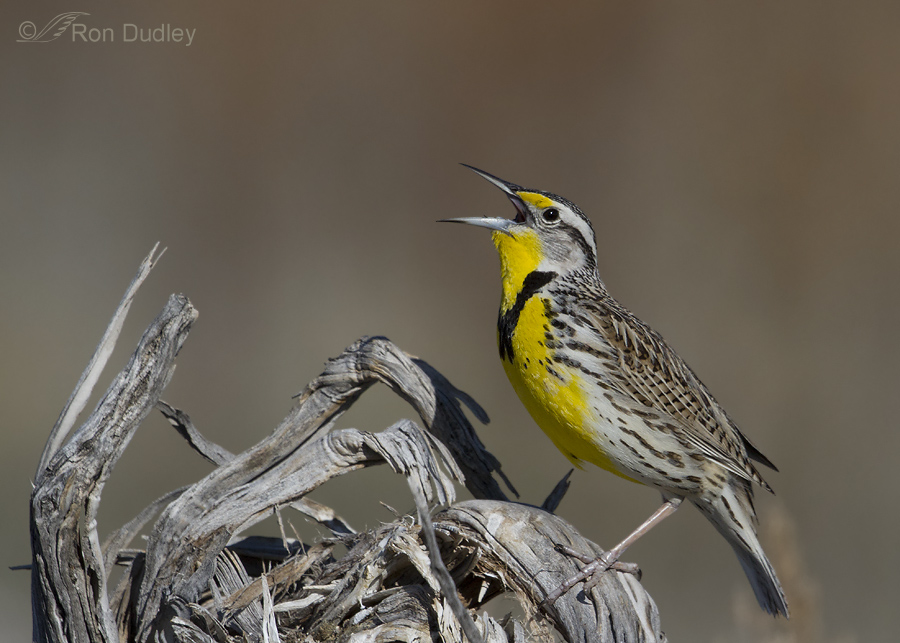Tag: singing
Green-tailed Towhees Singing On Territory
Vesper Sparrow

This morning I decided to feature another common and underappreciated species, the Vesper Sparrow. Friend and regular reader “Elephant’s Child” often refers to small, less colorful species as LBJs – “little brown jobs”. She appreciates the LBJs as much as their more colorful cousins and I give lip service to the fact that I do too but there’s no question that they get less attention on my blog than they deserve. This post is an attempt to partially remedy that situation.
Meadowlark Singing On Sagebrush
A Couple Of More Meadowlarks
I wanted to post two more recent Western Meadowlark images that weren’t take-off shots, like my last post of this species. 1/2500, f/6.3, ISO 500, 500 f/4, 1.4 tc, natural light This image, taken four days ago, shows the bright yellows on the belly, breast and throat but part of the bird is obscured. Obviously it was singing up a storm. Just looking at the image brings the song into my head. 1/5000, f/5.6, ISO 640, 500 f/4, 1.4 tc, natural light And this one, from two days ago, shows the backside. I was very close to this bird. So close that I had to shoot vertically, which complicates things with my long, awkward lens. By the time I had it framed and got off a few shots I realized that my settings were wrong for the situation (didn’t need the high ISO or shutter speed and more depth of field would have kept more of the sagebrush sharp) but by then it was too late and the bird took off. Sometimes birds cooperate and then they don’t… Ron PS – As I was working on this post which was meant to be published tomorrow morning I hit “publish” instead of “update” before it was ready. So there’s some “hiccups” in it, especially for those who get the post emails. Sorry. I’ve always worried about doing that…
A Meadowlark Morning
Yesterday morning there was meadowlark magic on the island. They were almost everywhere, singing lustily from atop their sagebrush and rabbitbrush perches (and more than a few ugly signposts). Several times I just stopped the truck, turned the engine off and got outside to listen. You could hear dozens of them simultaneously – some very close, some far away and others everywhere in between. Their melodious calls literally bounced off the hilltops.
My First Western Meadowlark Of The Season
Ok, despite the fact that it’s turning colder again this week I’m now convinced that spring has arrived because two days ago I finally got close enough to photograph a singing Western Meadowlark – my first of the year. 1/2500, f/6.3, ISO 640, 500 f/4, 1.4 tc, natural light I was sure the bird would fly off as I approached, just as all the others have this spring, but this one stuck. I like the somewhat different head angle in this shot. 1/2000, f/6.3, ISO 500, 500 f/4, 1.4 tc, natural light I probably have more trouble with framing this species than any other because their legs are always longer than I think they are when they’re buried in the perch like this and I typically don’t leave enough room for at least one of them. This time I think I did. 1/3200, f/6.3, ISO 640, 500 f/4, 1.4 tc, natural light When the bird would break out in song it truly lifted my spirits, as it always does. They’re just so enthusiastic about it and when you’re close the sound can go right through you – in a good way. I’m always impressed by the size of their mouth which seems to be exaggerated some by that long beak. I suspect there are a few of my regular readers who are unfamiliar with the call of this songster (Elephant’s Child in Australia, for example) so I’ve provided a link to their song if you’d like to hear it (scroll down about half-way). These birds (and their…
A Few Recent Loggerhead Shrikes
There’s always a few Loggerhead Shrikes that winter-over on Antelope Island and I find them to be fascinating subjects. Their approachability is very unpredictable but occasionally they’ll allow me to get close, especially when it’s very cold in the mornings or if they’re about to hack up a pellet. These are images I was able to get in the last few weeks. ***Note: The last image in this post is graphic. If your sensibilities might be offended by such a photo please stop scrolling before you get to the last (6th) image. 1/3200, f/5.6, ISO 500, 500 f/4, 1.4 tc This bird was practicing its springtime melodic repertoire a few weeks early (image taken on 2/5/12). It was a relatively warm, sunny morning and it was singing its little heart out (if you can call shrike calls “singing”). 1/2000, f/6.3, ISO 400, 500 f/4, 1.4 tc With their black masks these shrikes always remind me of little bandits and they have an attitude to go along with that perception. They get their name from their unusually large head (loggerhead means “block head”). 1/8000, f/5.6, ISO 500, 500 f/4, 1.4 tc I like the soft, even light and the setting in this image even though the twigs in front of the bird may not be ideal for some. 1/640, f/7.1, ISO 640, 500 f/4, 1.4 tc I’m including this shot just for fun. I liked the fluffy, relaxed pose to go along with the yawn. 1/1250, f/7.1, ISO 500, 500…
Lazuli Buntings of the San Rafael Swell
For me Lazuli Buntings have long been an elusive subject. Though they’re common in the western U.S. I rarely see them near my home and when I’ve found them in my travels they either won’t let me get close or they’re buried in thickets where I can’t get clean shots of them. All that changed on an early June photo/camping trip to Utah’s remote and visually stunning San Rafael Swell. 1/1600, f/8, ISO 400, 500 f/4, 1.4 tc I found the males singing on territory and more cooperative than usual since their preferred singing perch was at the top of low shrubs and they were often so involved with their melodious territorial declarations that they sometimes let me approach them quite closely. This one is perched on greasewood which provided some nice green colors in this arid habitat that they prefer. I like this good look at the bi-colored bill of the species. 1/1250, f/7.1, ISO 400, 500 f/4, 1.4 tc At times one of these males would give me a clean perch and background for a typical “bird on a stick” image. 1/1250, f/6.3, ISO 400, 500 f/4, 1.4 tc But more often than not the perch would be more cluttered. Here I’m less than happy with the out of focus twigs in the foreground but I liked the cottonwood “cotton” stuck to the bill. The unusual background color is from the Entrada Sandstone so common in the area. 1/1250, f/8, ISO 200, 500 f/4, 1.4 tc I’ve seldom seen birds get so…
Marsh Wrens of Bear River Migratory Bird Refuge
This week I was finally able to get some decent images of Marsh Wrens. Canon 7D, 1/2000, f/8, ISO 400, 500 f/4, 1.4 tc In the past these birds have always been buried too deeply in vegetation for me to get shots I liked but a couple of days ago they finally cooperated with me. Canon 7D, 1/1600, f/8, ISO 400, 500 f/4, 1.4 tc Marsh Wrens have incredibly interesting behaviors. For example, western males must learn up to 200 different songs (eastern birds only learn about 50). Perhaps that’s why these males sing so much – it would take a lot of practice to learn that many “tunes”. Canon 7D, 1/1600, f/8, ISO 400, 500 f/4, 1.4 tc These birds are extremely territorial and aggressive. They are polygynous (males mate with multiple females) and in order to attract females the male builds from 6 to 22 “dummy” nests for every one that is actually used to raise a brood of chicks. We could see several of these nests buried in the cattails along the refuge road. Canon 7D, 1/2500, f/7.1, ISO 400, 500 f/4, 1.4 tc According to the Bear River Blog many of these nests were destroyed by our recent stormy weather and heavy rains so many of these males have had to start over. Canon 7D, 1/2000, f/8, ISO 400, 500 f/4, 1.4 tc Marsh Wrens of both sexes regularly destroy eggs and chicks of other birds near their territories, including those of…
Horned Larks Blowin’ in the Wind
I have particularly fond memories of Horned Larks from growing up on our northwestern Montana family farm near Cut Bank, Montana. The fallow barley fields and adjacent short grass prairies abounded with them. But since I began photographing birds I’ve had very few opportunities with them here in Utah – until last week when had a grand time with multiple cooperative larks in the foothills of the Stansbury Mountains. And yes, the wind was blowing briskly – a perfect situation to remind me of those Montana larks! Singing in the wind The wind seemed to inspire the males to sing as they all seemed to be singing up a storm on this day, despite the early February date. Blown off the perch While it may look like this male is taking flight, in reality it was being blown off the perch by a sudden gust of wind. If it had been taking off, both wings would be extended. Wind- disheveled feathers In this photo, the wind updraft from the rock perch blew a perfect semicircle of his upper chest feathers into his black neck ring, making him look pretty silly. Very obvious “horns” This photo shows the “horns” (occipital feather tufts) that are characteristic of the species. The horns are found on both sexes but they are much less obvious in the female and rarely erected. This frontal view of the head shows the horns most distinctly when they are raised. Horns laying almost flat At times the horns are laid flat against the…




